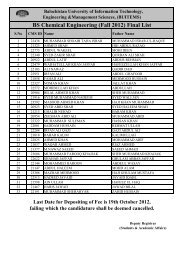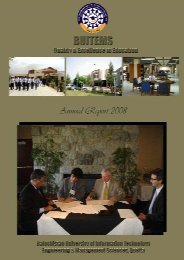BUITEMS
Research Journal - buitems
Research Journal - buitems
- No tags were found...
Create successful ePaper yourself
Turn your PDF publications into a flip-book with our unique Google optimized e-Paper software.
<strong>BUITEMS</strong><br />
Quality & Excellence in Education<br />
from the sender along the road in the message<br />
forwarding direction. Each sector is assigned<br />
a fixed length contention window W n as<br />
described in equation (1) . Within each<br />
sector, the road section is further subdivided<br />
width-wise into cells with cell width equal<br />
to that of one lane. Each cell is then assigned<br />
a fixed time slot from the corresponding<br />
contention window. Length of a cell (along<br />
the horizontal axis in Figure 1) is significant<br />
in the proposed mechanism. One cell in our<br />
scenario strictly spaces one vehicle in order<br />
to completely avoid collision. Therefore, we<br />
cautiously assume sector length (or cell<br />
length) as 13 meters, although (Bauer et al<br />
., 2004) reports that the average vehicle<br />
spacing in a city freeway is about 16.8 meters<br />
(equal to four car lengths; average car length<br />
being 4 meters). Node within each cell backs<br />
off for its assigned amount of time.<br />
Consequently, in our scenario the node in N<br />
th sector (furthest) sector with time slot t 1<br />
will rebroadcast first. All the remaining nodes<br />
with higher back off values would overhear<br />
the rebroadcast and would subsequently quit<br />
their rebroadcast step. The rebroadcast from<br />
the relay node is also overheard by the<br />
original sender, this will confirm successful<br />
reception of the safety message. In case the<br />
rebroadcast message is not heard by the<br />
original sender within the specified time<br />
(timeout), the broadcast is repeated by the<br />
original sender. Note that the movement of<br />
vehicle (50 miles per hour on average)<br />
relative to message propagation speed (25<br />
meters per millisecond on average according<br />
to simulations in section IV) is negligible to<br />
influence the message overhearing<br />
mechanism. The same mechanism is<br />
repeated in the remaining hops until the<br />
message propagates across the intended<br />
distance.<br />
Delay Analysis<br />
Since this work focuses on the rebroadcasting<br />
stage in VANET multi-hop safety message<br />
propagation, we confine our delay analysis<br />
to the rebroadcasting step in the message<br />
prop- agation scenario. The rebroadcast<br />
delay in a normal sectoring mechanism<br />
is formulated first, followed by the rebroadcast<br />
delay in lane based sectoring. We assume<br />
Introducing Lane Based Sectoring for Routing in VANETs<br />
the traffic distribution is uniform and that there<br />
are fixed number of contending nodes (CN<br />
) for each sender. We follow Bianchi’s Markov<br />
chain model (Bianchi, 2000) to formulate<br />
one hop delay for our broadcasting<br />
mechanism. Let t r be the transmission time<br />
of the packet given by<br />
where hP H Y and hM AC are the PHY and<br />
MAC headers (MAC header also includes our<br />
protocol overhead). Rb is the data rate and δ<br />
is the propagation time. We assume the same<br />
data rate for payload, PHY and MAC header<br />
transmission. Let τc be the transmission<br />
probability of a contending node. The<br />
probability of unsuccessful transmission<br />
becomes<br />
P r = 1 − (1 − τc )C N (3)<br />
From (Bianchi, 2000), the probability that a<br />
node starts its transmission in a given time<br />
slot is given by<br />
where N and l are number of sectors and<br />
number of slots from (1). τc can be<br />
analytically computed from (Bianchi, 2000)<br />
and equation (4).<br />
The probability that a transmission occurs<br />
among contender nodes in a given time slot<br />
is<br />
Probability that a packet is successfully<br />
transmitted given<br />
Ptr is<br />
From (Blaszczyszyn et al., 2009) and the above<br />
equations, we can write the average delay for<br />
message rebroadcast E[D] as<br />
E[D] = E[x]E[t] (7)<br />
Where<br />
82
















